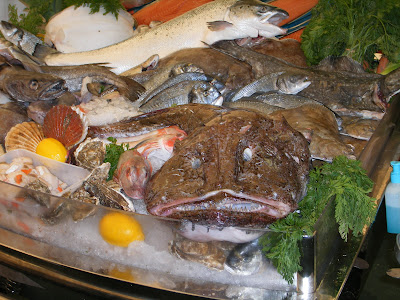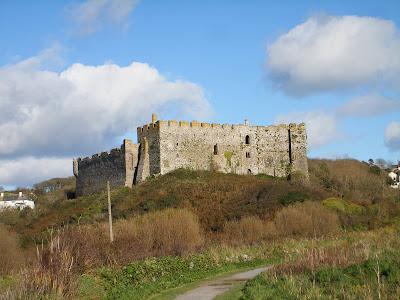One of my favourite novels is 'Lady of Hay' by Barbara Erskine. I renewed my acquaintance with it again last year and it was every bit as good as I remembered it. An excellent precis, if you haven't already read the book, can be found at: http://louisabrown.net/LadyHay.htm
The name of William de Braose was of course connected with both Skenfrith Castle and White Castle, which I visited on Monday. In the height of his powers (he was a favourite of King John's), he was Lord of Gower, Abergavenny, Brecknock, Builth, Radnor, Kington, Limerick, Glamorgan, Skenfrith, Grosmont, White Castle and Briouze in Normandy.
de Braose was not born in Wales, but had his roots in Sussex - he was 4th Lord of Bramber. He inherited large estates in what is Monmouthshire today through his mother, Bertha of Hereford.
 [View from the Keep at Skenfrith.]
[View from the Keep at Skenfrith.]He was not a man to be trifled with and when his uncle Henry died at the hands of Welsh enemies - he believed the principal protagonist to be Seisyll ap Dyfnwal of Llanover in the Usk Valley - de Braose sought his revenge by inviting three Welsh princes, including Seisyll, to a Christmas feast at Abergavenny Castle. There he had them murdered, which resulted in great antagonism against him from the Welsh, who called him the 'Ogre of Abergavenny'. Despite Gerald of Wales (Geraldus Cambrensis) having faith in him, it is understood that de Braose still pursued his blood feud against Seisyll's family and killed his son and heir Cadwaladr, who was only seven years old.
In 1206 King John granted the Lordships of the Trilateral castles of Gwent - Skenfrith, Grosmont and White Castle to de Braose, possibly as a bribe for his silence over the capture and subsequent death of Arthur of Brittany, captured by de Braose at the Battle of Mirabeau in 1202. Arthur would have been a strong contender to the throne on John's death.
 [Inside White Castle]
[Inside White Castle]Perhaps the King eventually saw him as too much of a threat, or a loose cannon - in all events, he took against him and pursued him for debts, seizing the de Braose lands in Sussex and Devon and pursuing de Braose' wife, Maude de St Valery, who made no secret of the fact that she believed that Arthur of Brittany had been murdered. They fled to Ireland, and then escaped to return to Wales to join Llywelyn the Great in his uprising against King John. In 1210, de Braose excaped to France in the guise of a beggar, but his wife and eldest son, William, were captured and held in Windsor Castle and Corfe Castle, Dorset, where it is believed they were starved to death. He himself died in France in 1211. The burial in Brecon which he had planned for himself was denied and his body rests in the Abbey of St Victor in Paris.
What a good base for Barbara Erskine's gripping tale (you will find it hard to put down, I promise) and what a good excuse to visit the lands and castles of the Marcher Lords . . .























































